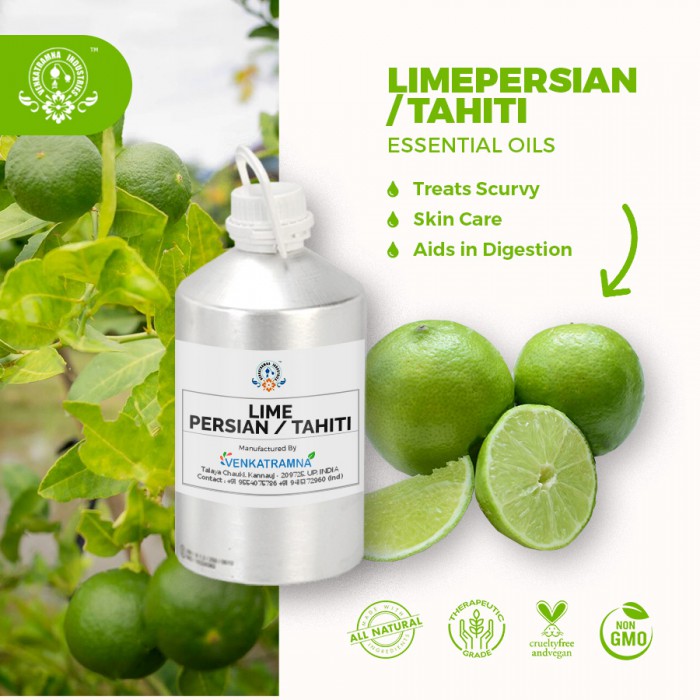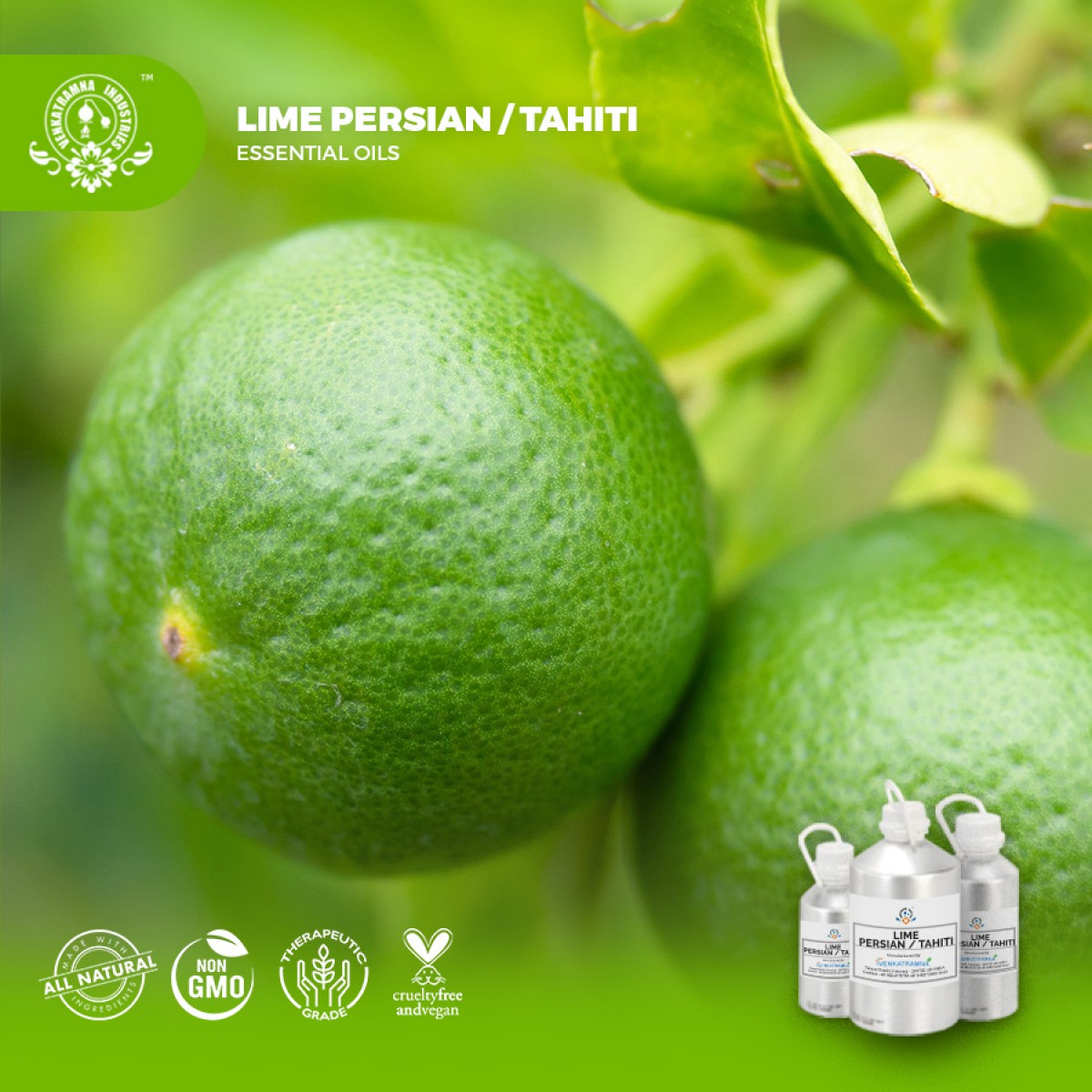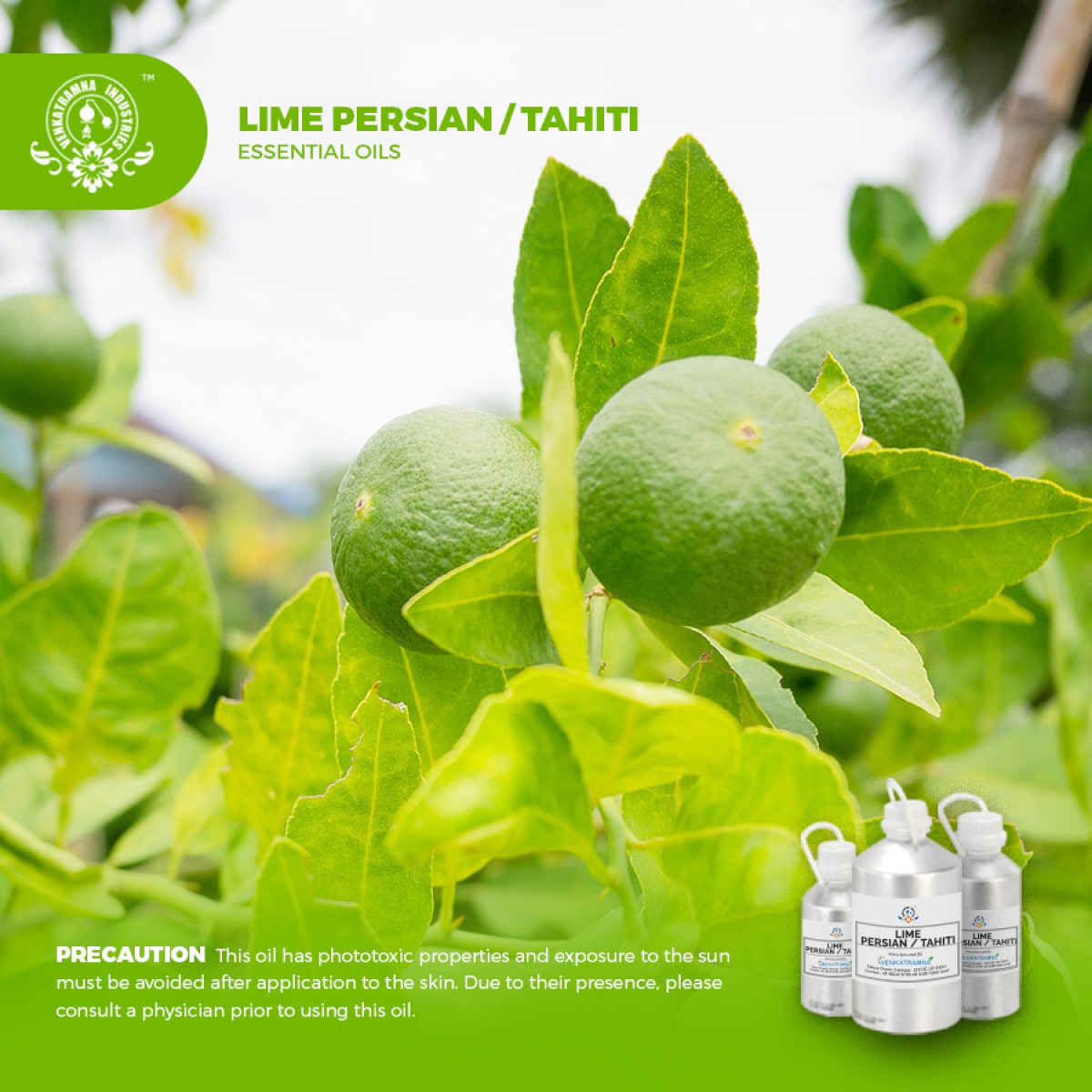Botanical Name: Citrus latifolia tanaka Common name: Lime, lemon, seedless lime, Bears Read More
|
Botanical Name: |
Citrus latifolia tanaka |
|
Common name: |
Lime, lemon, seedless lime, Bearss lime and Tahiti lime |
|
Plant
family: |
Rutaceae |
|
Genus: |
Citrus |
|
Appearance/Color: |
A thin, clear, yellowish green to greenish brown liquid. |
|
Odor: |
A top note with a medium aroma, it has a tart, fresh scent
characteristic of the fruit. |
|
Blends With: |
Bergamot, Cedar Wood, Geranium, Grapefruit,
Lavender, Lemon, Mandarin, Neroli, Nutmeg, Orange, Palmarosa,
Petitgrain, Rose, Rosemary, Rosewood, Vetiver and Ylang-Ylang. |
|
Origin: |
Brazil |
|
Source: |
Fruit Peel |
|
Method
of Extraction: |
Steam Distillation |
Lime Essential Oil is amongst the
most affordable of essential oils and is routinely used for its energizing,
fresh and cheerful aroma. It is well known in folklore for its ability to
cleanse, purify and renew the spirit and the mind. It is also said to be
effective in cleansing the aura. Lime essential oil is rich in Vitamin C,
making the oil an ideal immune system booster. Lime can be used in a diffusor
or vaporizer to assist with relief from stress, anxiety, and allow for a calm
mind.
It is an important medicinal and
food plant widely cultivated in many parts of the world. It is valued for its
nutritional qualities and numerous health benefits. The plant is used in
traditional medicine as an antiseptic, antiviral, antifungal, anthelmintic,
astringent, diuretic, mosquito bite repellent, for the treatment of stomach
ailments, constipation, headache, arthritis, colds, coughs, sore throats and
used as appetite stimulant. These health benefits of Lime are associated
with its high amounts of photochemical and bioactive compounds such as
flavonoids, limonoids, phenols, carotenoids, minerals and vitamins.
Although the precise origin is uncertain, wild limes are believed to have first grown in Indonesia or Southeast Asia, and then were transported to the Mediterranean region and north Africa around 1000 CE. To prevent scurvy during the 19th century, British sailors were issued a daily allowance of citrus, such as lemon, and later switched to lime. The use of citrus was initially a closely guarded military secret, as scurvy was a common scourge of various national navies, and the ability to remain at sea for lengthy periods without contracting the disorder was a huge benefit for the military. The British sailor thus acquired the nickname, "Limey" because of their usage of limes.
DISCLAIMER
The complete range of conditions
or methods of use are beyond our control therefore we do not assume any
responsibility and expressly disclaim any liability for any use of this
product. Information contained herein is believed to be true and accurate however,
all statements or suggestions are made without warranty, expressed or implied,
regarding accuracy of the information, the hazards connected with the use of
the material or the results to be obtained from the use thereof. Compliance
with all applicable federal, state, and local laws and local regulations
remains the responsibility of the user.
The FDA has not evaluated the
statements on this website. No claims are made by Venkatramna Industries as to
the medicinal value of any products from vriaroma.com or by us. The information
presented here is for educating our customers about the traditional uses of
essential oils and is not intended to diagnose, treat, cure, or prevent any
disease. You are responsible for understanding the safe application of these products.
If you have any questions, please call or email us for further information.
As per NAHA guidelines, New Directions Aromatics
(NDA) does not recommend the ingestion of essential oils. It is imperative to
consult a medical practitioner before using Essential Oils for therapeutic
purposes. Pregnant and nursing women and those taking prescription drugs are
especially advised not to use this product without the medical advice of a
physician. The oil should always be stored in an area that is inaccessible to
children, especially those under the age of 7.
Lime
Essential Oil possesses multiple therapeutic potentials. These
biological credentials include anticancer, antianxiety, antiobesity,
antibacterial, antioxidant, pesticidal, and antidiabetic activities. The
essential oil of Lime was reported to display marked
pharmacological effects and great variation in chemical composition depending
on growing locations but mostly contained limonene, linalool,
and ?-myrcene. Phytochemically, Lime is rich
in p-synephrine, an alkaloid, and many health-giving secondary metabolites
such as flavonoids.
Lime Essential Oil in Pharma
The chemical composition of Lime
is responsible for health-promoting effects. The chemical composition
includes vitamins, minerals, phenolic compounds, and terpenoids. Among the
diverse chemical components in lime, flavonoids belonging to
phenolics have been recognized as important due to their physiological and
pharmacological role and their health benefits, include anticancer,
antianxiety, antiobesity, antibacterial, antioxidant, pesticidal, and
antidiabetic activities.
Essence of Lime Essential Oil
Lime
Essential Oil is usually utilized as a flavoring and acidifying agent
for food. Besides the essential oil and its components, the fruits of Lime
are sources of flavonoid-type compounds with diverse biological effects.
Additionally, it was reported that flavonoid glycosides were isolated from the
plant and the biogenic amine and flavanone contents have been determined. Due
to the abundance of health-giving secondary metabolites
COMMON
USAGE
·
Treats Arthritis
·
Eye Care
·
Cures Fever
·
Treats Piles
·
Defends against Cholera
· Treats
Urinary Disorders
·
Treats Scurvy
·
Skin Care
·
Aids in Digestion
·
Weight Loss
·
Relieves Constipation
·
Manages Diabetes
·
Prevents Heart Diseases
·
Heals Peptic Ulcer
·
Treats Respiratory Disorders
Ingredients:
|
S.No |
Key Constituents |
Strength (%) |
|
1 |
(p)-Limonene-(p)-1,8-cineole
|
55.6 |
|
2 |
g-Terpinene |
11.8 |
|
3 |
a-Terpineol |
6.6 |
|
4 |
Terpinolene |
5.2 |
|
5 |
b-Myrcene |
2.6 |
|
6 |
(Z)-b-Terpineol |
2.2 |
|
7 |
Terpinen-1-ol |
1.9 |
|
8 |
a-Pinene |
1.8 |
|
9 |
b-Pinene |
1.8 |
|
10 |
1,4-Cineole |
1.8 |
|
11 |
p-Cymene |
1.5 |
|
12 |
Terinen-4-ol |
1.3 |
|
13 |
a-Fenchol |
1.1 |
Safety
Summary
·
Hazards:
Skin sensitization if oxidized
·
Phototoxic:
may be photo carcinogenic.
·
Cautions (dermal): If
applied to the skin at over maximum use level, skin must not be exposed to
sunlight or sun bed rays for 12 hours.
Old or oxidized oils should be avoided.
Maximum
dermal use level 0.7%
Safety
Advice
Because of its (?)-limonene content we
recommend that oxidation of expressed lime oil is avoided by storage in a dark,
airtight container in a refrigerator. The addition of an antioxidant to
preparations containing it is recommended.
Organ Specific Effects
·
Adverse skin reaction:
No irritation or sensitization data could be found. Expressed lime oil was
phototoxic when applied to human skin. Photo toxicity is due to bergapten and
other furanocoumarins. Bergapten is photo carcinogenic. Eleven cases of photo
dermatitis from expressed lime oil have been reported, and photodynamic reaction
was experimentally produced by expressed lime oil on the skin and subsequent
solar irradiation. Auto oxidation products of (?)-limonene can cause skin
sensitization
·
Reproductive toxicity:
The low reproductive toxicity of (?)- limonene and ?-pinene suggests that
expressed lime oil is not hazardous in pregnancy.
Systemic Effects
·
Acute
Toxicity: No information found.
·
Antioxidant/pro-oxidant activity:
Persian lime oil has demonstrated marked DPPH radical scavenging activity. Lime
terpenes induced glutathione S-transferase activity to more than 2.5 times
control level in mouse tissues.
·
Carcinogenic/anti carcinogenic potential: Lime
oil (type unspecified) has been reported as a promotor of tumors in the fore
stomach and in the skin of rats pretreated with DMBA; most of these papillomas
were benign, but a few were malignant. Lime oil was not mutagenic in the Ames
test, and did not produce CA in Chinese hamster fibroblasts. Citral and (?)-limonene
display anti carcinogenic activity.
·
Ecotoxicity
Very toxic to
aquatic life with long-lasting effects EC50 (algae/aquatic plants) 55.9 mg/l
(48h) - RIFM
·
Mobility
Not determined
·
Persistence & Biodegradability
Considered
readily biodegradable Bioaccumulation Potential Considered low considering
expected biodegradability
·
PBT Assessment Results
No additional
data available
·
Precautions
Do not
discharge into the environment especially not into waterways, sewers and the
sea.
·
Disposal Methods
Do not release into
the environment. Collect waste into suitable containers and contact hazardous
chemical disposal company.





 MSDS-Lime1.pdf
MSDS-Lime1.pdf




